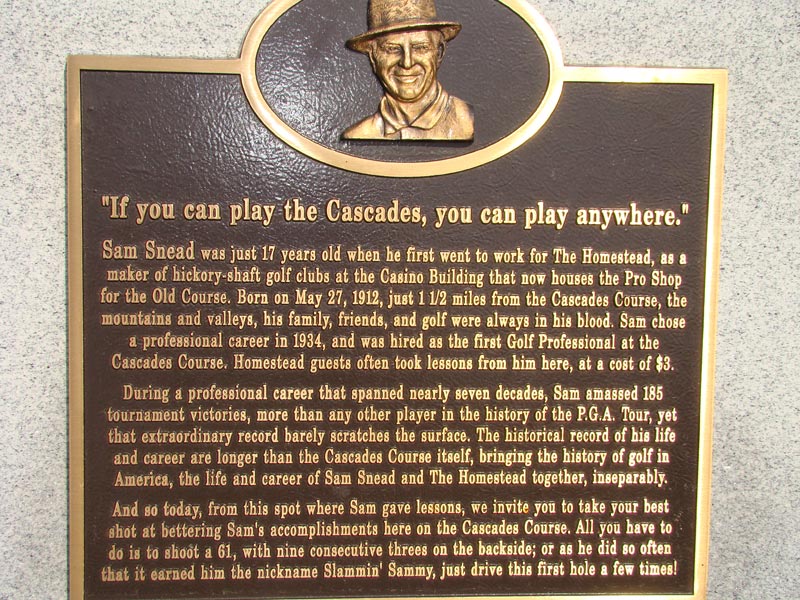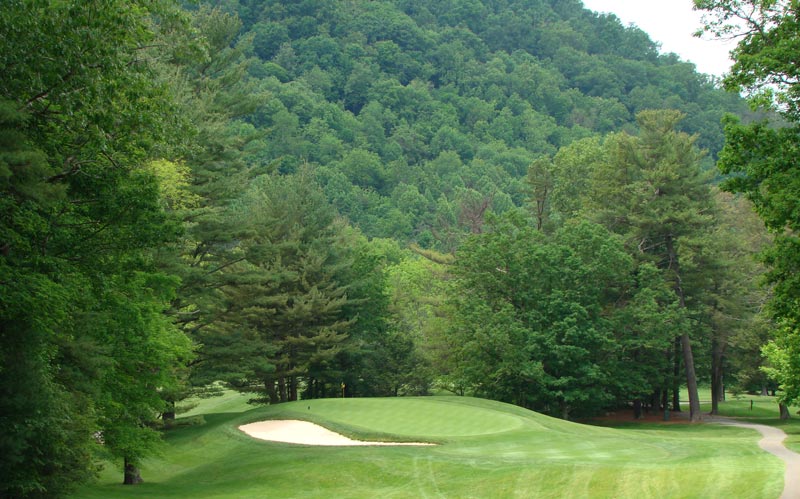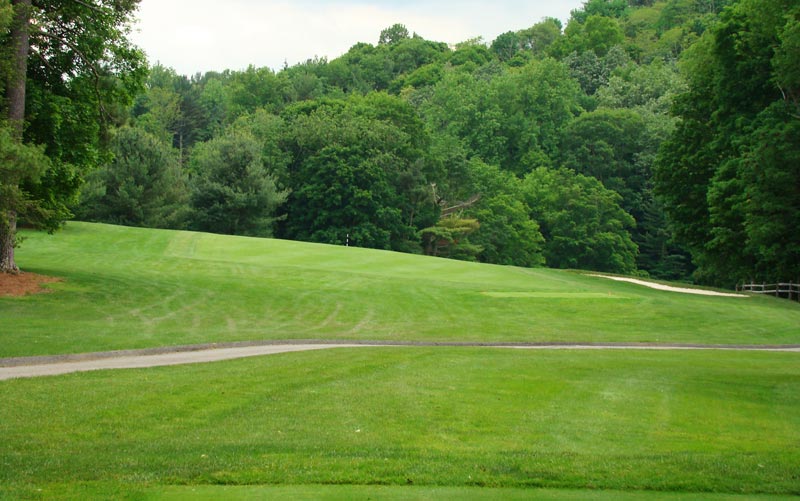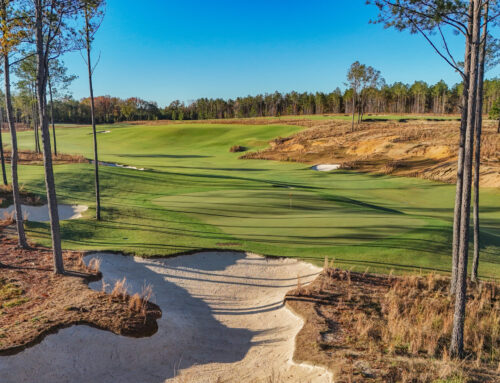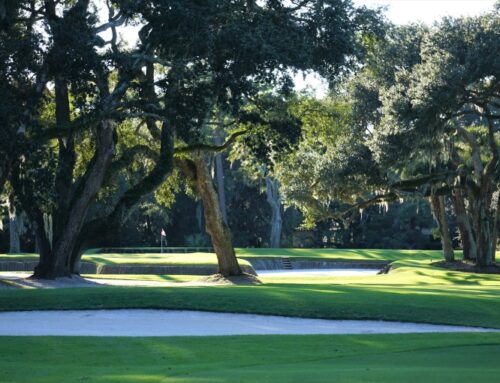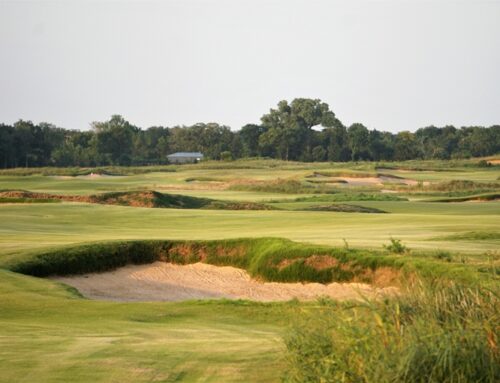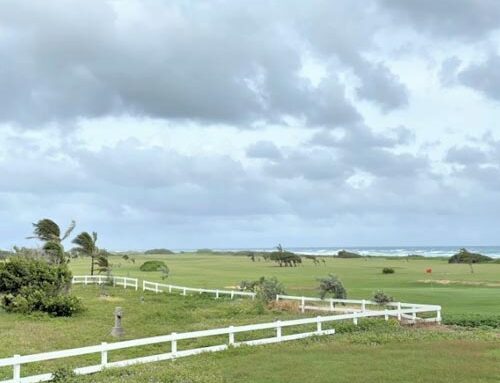The Cascades Golf Course
VA, USA
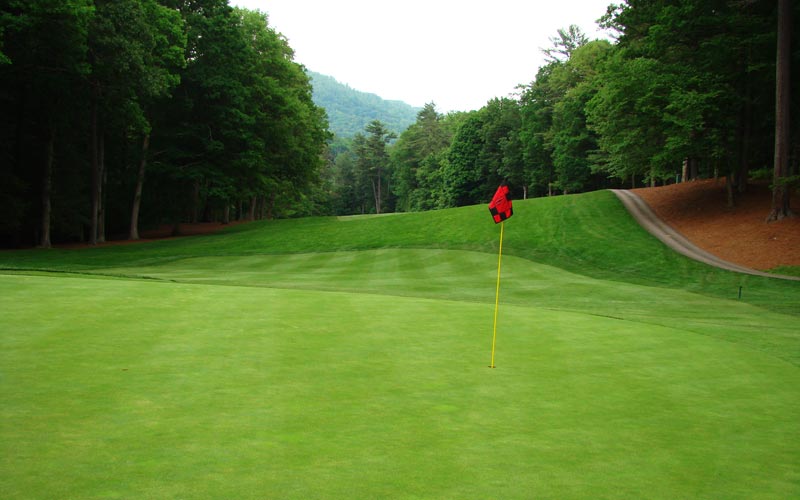
The Cascades presents an intriguing challenge, balanced between the sloping terrain on the front nine (pictured is a view back down the second fairway) and ….

… the natural water hazards found throughout the back nine (pictured is the stream along the right of the seventeenth hole).
Tied to the justly world famous Homestead Resort in Hot Springs, The Cascades Golf Course has remained one of William Flynn‘s most notable works. This is as it should be, in part because William Flynn spent over a dozen years continually refining and improving his original work as both he and his wife cherished their annual visit to The Homestead. Given the diverse natural features of which he took full advantage, it is no wonder that the course has hosted many important events including the 1928 US Women’s Amateur won by Glenna Collett, the 1966 Curtis Cup, the 1967 US Women’s Open, the 1980 US Sr. Amateur won by William C. Campbell, the 1988 US Men’s Amateur, the 1994 US Women’s Amateur and 2000 US Mid-Amateur. However, golf courses are living, breathing things and the question now is: does the Cascades Golf Course still warrant its reputation as a world class golf course?
One thing is for sure and that is that The Cascades Golf Course did deserve its mighty reputation in William Flynn‘s day. Indeed, in many ways, it was an early harbinger of what William Flynn had to offer as he successfully – and apparently with great ease – was able to drape the holes over the land, creating varied stances and lies that required great skill in approaching pitched greens. Nothing jaw dropping but highly effective nonetheless at providing an engaging test as witnessed by the championships that it has hosted.
However, that’s not to imply that the property was an easy one with which to work. Indeed, two men before him cast doubt as to the land’s merit for golf. According to William Flynn historian Wayne Morrison, The Homestead in 1919 brought in Peter W. Lees but he was underwhelmed by the property’s potential. Undeterred by Lees’s negative report, The Homestead then retained A.W. Tillinghast in 1920 to both review Mr. Lee’s designs for an expanded Goat Course and to again evaluate the Rubino property for golf. Likewise, Tillinghast said that the Rubino land could not provide what was needed for good golf.
William Flynn was then invited to see the property and walked it along with Fay Ingalls through brier, weeds, bushes, cornfields, a cress lake, and along limestone ridges. By dusk, William Flynn announced that if a ¼ acre site with a tenant’s shack could be obtained (the site of today’s fourth green), an outstanding course could be constructed. Thus, The Homestead went ahead and acquired the Rubino property and hired William Flynn to design it.
Ever the efficient architect, William Flynn took only thirteen months to design and build The Cascades Golf Course. Trees were cut, cleared, and hauled to a mill for use on the construction of the course. Dynamite crews worked carefully so as not to disturb the mineral springs. Boulders as large as twenty tons (!) were removed. A 300-yard ridge of limestone was reduced. Tractors plowed, disc-harrowed and did finish grade work along with horses and mules. An irrigation system was put in. A steam shovel (a novelty back then for this area) filled in the watercress lake using 38,000 cubic yards of fill. Swift Run (a stream with a catchment area of twenty square miles) was redirected westward to the foot of Little Mountain in some areas and sent underground in others through 76-inch reinforced concrete pipes cast on the property.
Morrison notes that the materials used included: 20 tons of dynamite, 1204 tons of manure, 16 tons of fertilizer, 1287 tons of sand, 6 tons of seed, 208 tons of horse and mule feed, 83 tons of cement, 330 tons of crushed stone, 76 tons of building supplies, 32,000 linear feet of water pipe, 11,400 linear feet of rubber hose, 10,000 linear feet of drain tile, 20,000 linear feet of conduit and cable, 181,000 square feet of creeping bent stolons, 23,000 square feet of steel reinforcing, 38,000 square feet of lumber, 8,000 square feet of roofing, 12,000 gallons of gasoline and oil, and 400 gallons of paint.
Yet, as a true credit to William Flynn‘s skill as an architect, the end result of this large engineering effort is that the land looks like man has done little to it. This is indeed a rare gift for an architect to possess and few architects in history can match William Flynn in this regard.
The more one plays golf, the more one appreciates the lack of clutter at William Flynn‘s best designs and that is particularly true here. There no mounds anywhere and William Flynn‘s features hug the ground. Green complexes like the second, seventh, eighth and eleventh seem to be perfect extensions of the sloping terrain but in fact William Flynn moved a fair amount of dirt to prop up these greens and give the holes their golfing qualities.
William Flynn‘s earth moving also taxes the player’s perceptions on how a particular shot or putt will play. At the second hole, where the fairway slopes hard left to right, William Flynn propped up the right side of the green pad so that the putting surface actually slopes right to left. Such a tact makes the green more receptive to the approach, but it can also leave the player scratching his head as to which way his putt will break – should he look at the overall slope of the land or the specific pitch of the green? The fourth green is another optical illusion. The one-shotter drops sharply from the tee to the green below, which looks like it is pitched toward the tee as an inviting target. However, the green actually follows the slope down the hill, away from the tee. Many players stand perplexed on the tee as their tee ball continues to drift well past the hole. The eighth green is a combination of the themes of the second and fourth: from the tee of this 155 yarder, the green appears pitched back to front toward the tee. However, the front half follows the sidehill, left-to-right slope of the site as it runs away from the player while William Flynn built up the back-right portion of the green, sloping it from right to left.
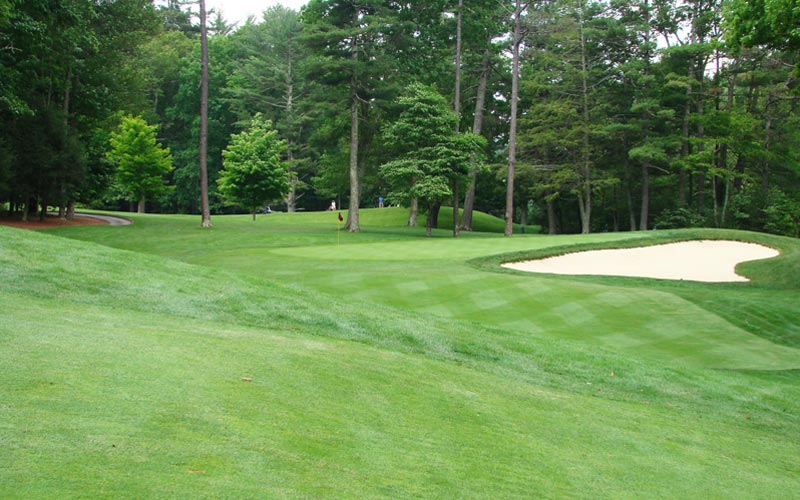
Though the second fairway slopes severely from left to right, Flynn’s built-up green pad slopes from high back right to low front left.
Unfortunately, some of William Flynn‘s work has been tampered with and in doing so, The Cascades Golf Course‘s reputation as one of William Flynn‘s – and the world’s – best is now in jeopardy. Bunkers have been removed, streams covered over, and two of William Flynn‘s best holes (the fourteenth and fifteenth) have been severely altered. Take the sixth hole as an example of a hole that no longer delivers much playing interest. In William Flynn‘s day, the sixth captured his ability to create a hole that is natural/simple in appearance and yet highly strategic. As he walked the property, he found a section of stream that ran in a straight line for approximately 360 yards. He placed the tee on the left side of the stream and eventually settled on placing a long oval green on its right, parallel to the stream. In this manner, the closer one flirts with the stream off the tee, the better his angle into the green. Most famously, William Flynn later carried out this same strategy at the fourth at Lancaster Country Club, which became one of his most recognized holes. The more the golfer shies away from the stream, the more oblique his angle becomes into the oval green on his approach. However, at some point in the 1980s, the section of stream from 150 yards to 260 yards from the tee was run underground, thus robbing the hole of William Flynn‘s strategic intent. Even worse, where the stream once was is now a horrid cart path! Similarly, on the back nine, one of his most interesting designs was the fourteenth, with twenty some bunkers making what would have been a highly strategic slight dogleg to the right. Thinking that this 360 yard hole needed a bit more muscle, The Homestead carried out Robert Trent Jones Sr.’s recommendation to move William Flynn‘s green left and thirty yards back in the late 1950s. Today’s fourteenth plays straightaway, holding little strategic interest, though Jones’ green does feature the most interior contour of any on the course. The tragedy of that move was exacerbated in that Jones then also moved the fifteenth tee, shoehorning it between his new fourteenth green and the first fairway. The result is the worst hole on the course and a dreadful substitute for William Flynn‘s original 250 yard fifteenth with its interesting playing angles.
Tree growth is another issue that has robbed The Cascades Golf Course of some of its past grandeur. Long views past the seventh and eighth greens are now masked while some fairways like the twelfth have become senselessly claustrophobic. Still, through all this, William Flynn‘s course remains refreshingly original and is certainly still a placement course. Distance isn’t the big concern, as only four of the two shotters are over 430 yards. The greens aren’t frightenly contoured. The bunkers aren’t deep (in part because there is so much rock underneath), and yet … the score mounts. Hit the sloping fairway and keep the ball beneath the hole. Sounds easy, but consistent with design work carried out in the 1920’s, if the land had pitch, so did the fairways. At The Cascades Golf Course, the second, fifth, seventh and ninth fairways continually serve up different stances and lies. The golfer then descends into the river bed bottom of the valley for the second nine, which features a flowing stream of mountain water on six holes. The stances are flatter but the penalty for mistakes escalates. Overall, the challenge is balanced between the two nines, and when combined, the golfer appreciates why Sam Snead, the course’s first Head Professional, famously said as per below, ‘If you can play The Cascades Golf Course, you can play anywhere.’
Holes to Note
Fourth hole, 200 yards, Carry On; The elevated tee gives the golfer a clear few of the small 3,400 square foot green well below and the setting’s beauty acts as the only consolation for this is one of the most demanding shots on the course. Given the thinner mountain air at this 2,500 foot elevation, club selection remains a perpetual mystery, just when accuracy is at a premium. Unfortunately, the terror of the hole has been dumbed down in recent years with the course’s deepest bunker removed from the left as well as a penal horseshoe bunker that once ran around the back. In addition, the course has lost one of its best hole locations when rough was allowed to take over ~200 square feet of putting surface of William Flynn‘s back right fill pad.
Fifth hole, 575 yards, Marathon; Throughout his design career and in his writings, William Flynn frequently warned that technology was reducing the challenge of the game as the player was no longer asked to hit controlled long shots. He wrote often about the need for distance and backed it up with his 7,000 yard Mill Road Farm Golf Course which opened in 1926 (!) in the age of hickory golf clubs. The Philadelphia based William Flynn was a definite fan of the genuine three shot hole, no doubt influenced by such holes as the fourth at Merion and the pair at Pine Valley. And to this day, the fifth at The Cascades Golf Course plays as a three shotter, thanks to William Flynn‘s use of a huge landform that created two separate and distinct island fairways. Standing on the tee, the view isn’t as dramatic as a par five with a Sahara bunker feature but the land form is every bit as effective at dictating play.

The long fifth features two ‘island’ fairways. The first island as seen here from the tee ends 300 yards from the back markers. The hill’s shoulder must be carried on one’s second shot to reach the second island fairway and it is much easier to do so from the fairway than the rough.
Seventh hole, 425 yards, Seventh Heaven; The elevated tee soaks up the view down the length of the valley. In fact, the view should be longer but trees behind the green ruin what would otherwise be a great view of the short eighth. As it is, the seventh plays across the slope of the valley hill with everything falling toward the right. A draw is the perfect tee ball as it offers both distance and hope of holding the sloping fairway. The approach shot is invariably with the ball below one’s feet; hitting a controlled mid-iron from this position is a shot of great skill (and satisfaction), but alas few ‘flat landers’ possess such ability.

A draw off the tee is ideal to hold the severe left to right sloping seventh fairway, which in fact should be expanded at least fifteen yards to its left. After all, the elevated tee makes this one of the more spectacular spots on the course and a thirty some yard wide fairway is woefully out of place in such a grand natural setting.
Eighth hole, 155 yards, Cemetery Ridge;Like the fourth, the initial prospect of playing the eighth is one of pleasure rather than apprehension. However, after just a few rounds, one learns to treat the eighth with great caution. Miss left and the left to right pitched green becomes difficult to hold on one’s recovery shot. Miss the right greenside bunker and the ball is kicked twenty plus yards away. A sharp fall behind offers no help either, making the putting surface a hit-it-or-else proposition.

The eighth green is a great one to hit in regulation as a big score can result otherwise. An outstanding long view behind the green is obscured by evergreen trees, which should be removed or at least thinned.
Ninth hole, 450 yards, The Take Off; The rugged nature of the property is showcased with this tee ball out of a chute of trees across a ravine to a rolling fairway. The approach is blind unless the golfer can fly the ball onto a plateau some 270 yards from the tee. Some might sniff at a long or mid-iron aimed at the target board in a tree behind the green, but in fairness to William Flynn, the green is open in front, giving the player plenty of margin for error. In fact, given the heaving landscape on the front, it would be a shame if such a shot didn’t exist as the blind approach actually represents natural golf with the ninth fitting the land that it is situated on as well as any hole on the course. Too many modern architects would make a cut in the hillside to give the golfer a better view, thus inadvertently ruining this hole’s uniqueness.
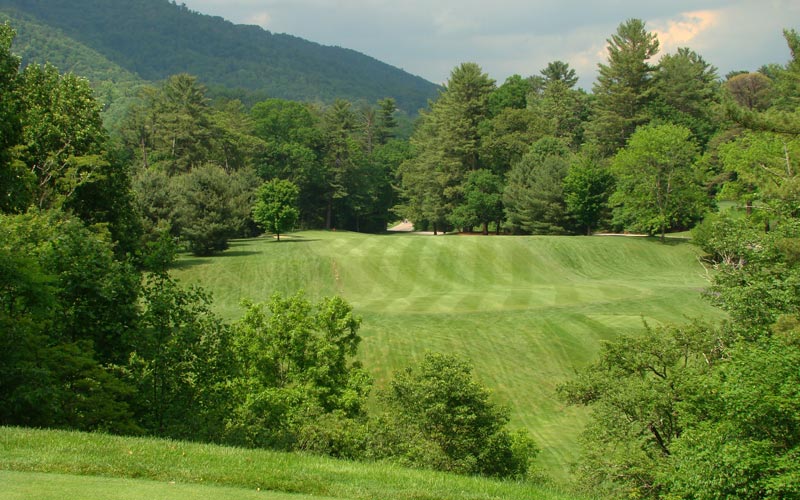
To reach the plateau at the top of the far hill is 270 yards from the back marker. A drive just short will likely roll back down the fairway and leave a blind approach.
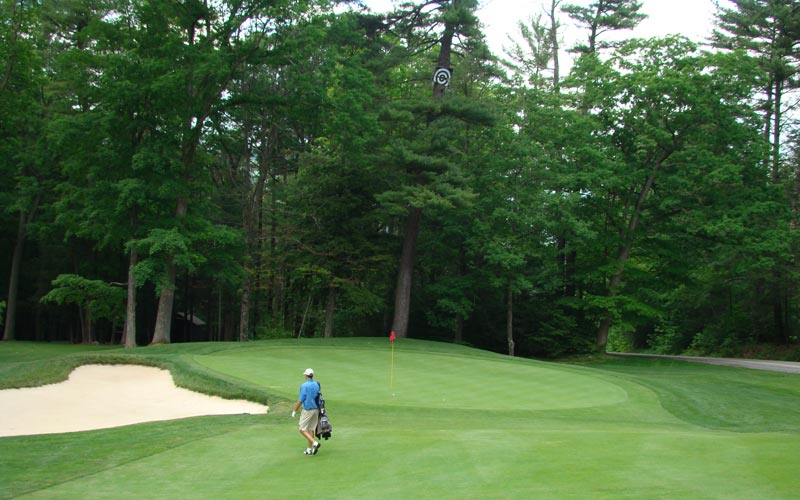
Note the white bull’s eye target well up in the pine tree as well as how Flynn left the green entrance open.
Tenth hole, 380 yards, Slippery Hollow; Arnold Palmer picked this hole among his favorite fifty-four holes in the United States. It is no wonder too that it stood out in Palmer’s memory as regardless of all the holes he has seen around the world, none is quite like this one. In some ways, this hole is ‘double blind’ with the fairway disappearing over the brow of the hill and tumbling down two distinct levels. Those that reach only the first half of the lower plateau are left with another blind shot down to the green. Flynn’s placement of the green in the flat below makes it difficult to read, as there is no predominant feature to orient the golfer as to which way putts break.
Eleventh hole, 190 yards, Lucky Strike; A crucial trait for an architect’s work to possess is that the golfer can’t tell where nature ends and man’s hand begins. In the case of The Cascades, though it doesn’t look like it, Flynn pushed plenty of dirt to create many of the green complexes and give them good golfing qualities, especially on the hilly front nine. Another case in point is the eleventh green complex which seems like a natural extension of the hillside to the left but is in fact totally manufactured. Flynn perfectly benched the eleventh green site into the left hillside.
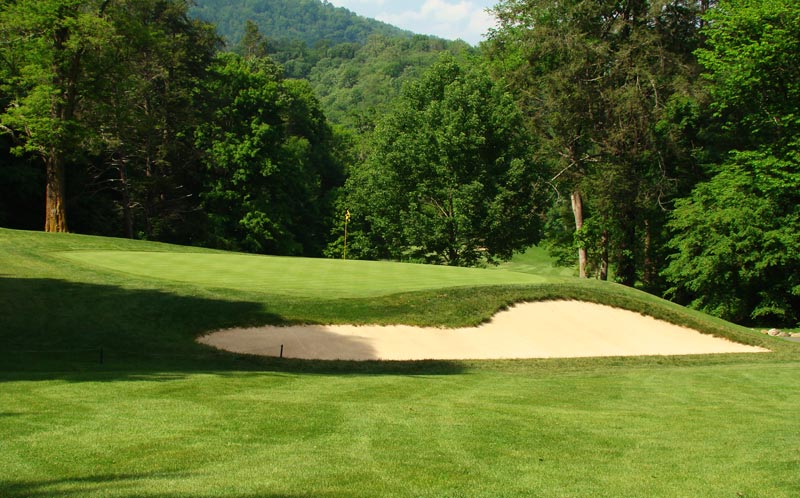
No mounding clutters the back of the eleventh green complex, though unfortunately trees do, thus robbing the course of what would again be another great long view.
Twelfth hole, 475 yards, The Vale; This hole is often singled out as the finest golf hole inVirginia. The fairway is placed in a sixty yard wide corridor between a steep seventy foot ridge on the right and a meandering stream on the left. What a sight the hole must have been in Flynn’s day and what a joy it must have been for him when he found this playing corridor when he was routing the course. Again though, time hasn’t been particularly kind to it. First, a cart path was added down the left, right alongside the stream. Then, in an effort to hide the ugly scar, trees were allowed to grow. In June, 2009, the twelfth fairway measured a scant thirty yards in width (essentially what a U.S. Open fairway measures), in stark contrast to the old photographs from Flynn’s day that indicate a fifty yard wide fairway with long views down the length of the hole. What a pity that the scale of this all-world hole has been compromised over the past several decades.
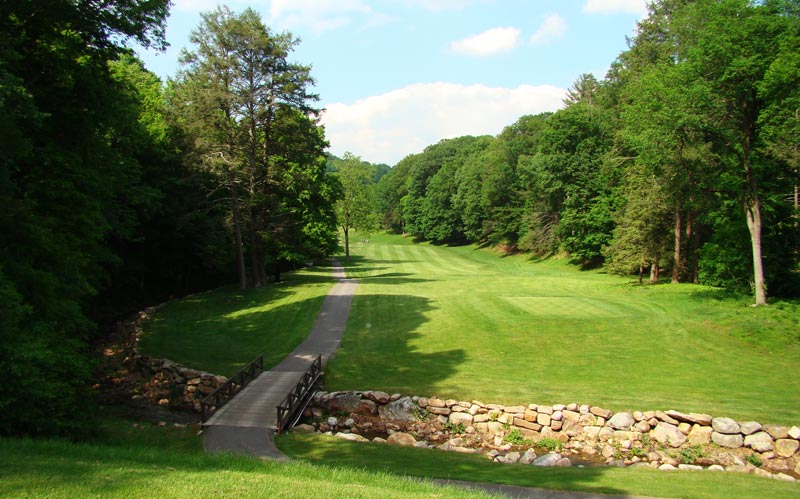
The dreadful placement of the cart path has led to tree growth on the right side of the steam and to a ridiculously narrow fairway for such a grand hole.
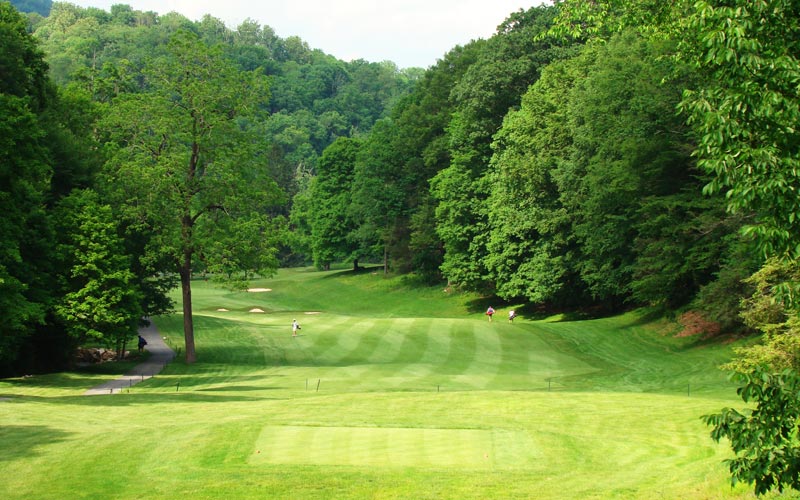
With a stream left and tree-lined hillside right, the golfer’s task is clear. He needs to hit driver to cover the distance and if he can find the fairway, the good news is that he should have a relatively level stance, something he may not have seen much of to this point in the round.
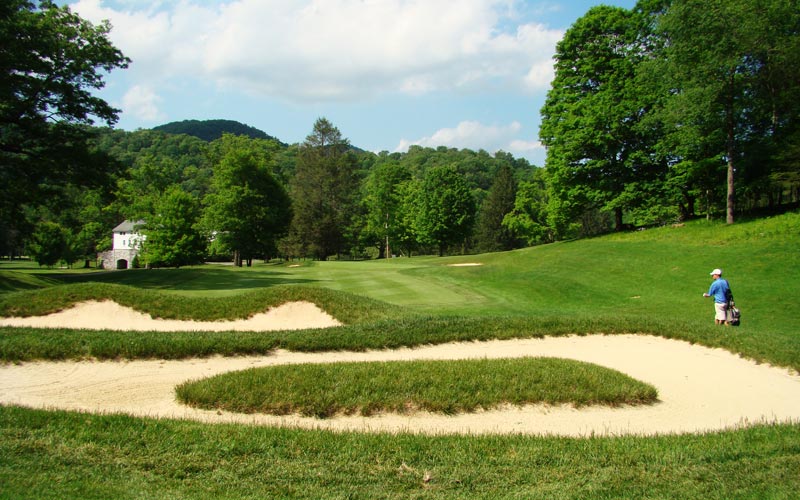
The golfer that doesn’t find the twelfth fairway needs to be wary of Flynn’s cross bunkers ninety yards shy of twelfth green. These bunkers were handsomely restored as part of a bunker project that the course undertook in 2007 as part of a Master Plan submitted by Wayne Morrison and Tom Paul.
Thirteenth hole, 440 yards, Swift Run; The same stream from the twelfth runs along the left edge of the thirteenth fairway, informing the thinking man that this hole moves downhill. One’s eyes can deceive/betray the first time golfer into thinking that the hole is flat and in a rarity, amateur golfers frequently find their approach shot ending up well past the day’s hole location. The ground just in front of the open green is frequently the ideal place to land one’s approach as the ball will bumble its way toward the green’s middle.
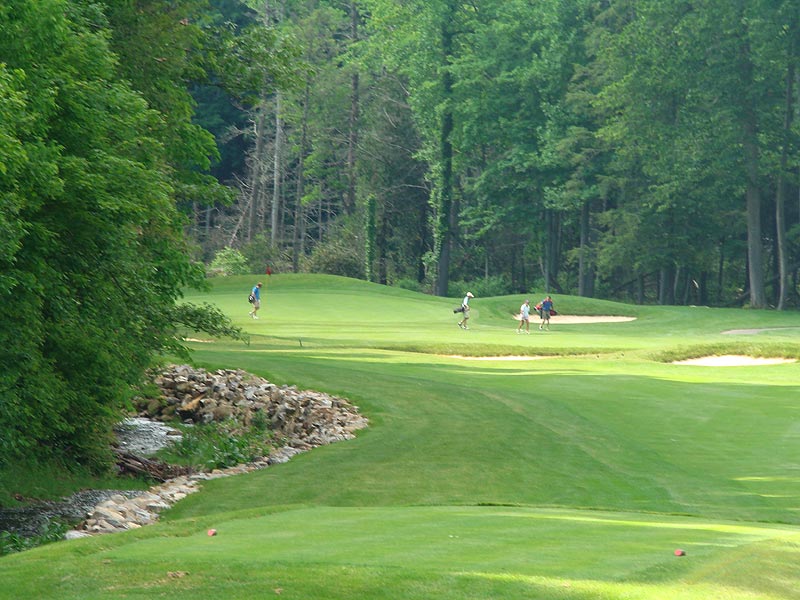
The thirteenth fairway bends gracefully left along the stream and the golfer that can draw his tee ball should have the advantage. Unfortunately, rough has been allowed to grow too far out from the stream, thus undermining some of the hole’s driving appeal.
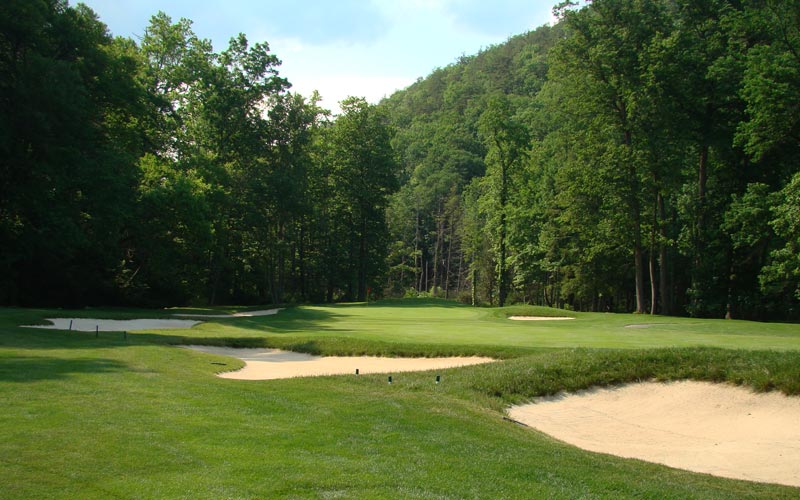
The attractive approach to the thirteenth. After the round, study Flynn’s drawing in the clubhouse of this hole as it shows a creek in lieu of this echelon of bunkers (!).
Sixteenth hole, 525 yards, The Hemlocks; One of the game’s great gambling holes and the start of a thrilling 5-5-3 par finish, this hole combines great beauty with strategy galore. After a good drive past a nest of three bunkers on the inside of this dogleg right, the player debates whether to go for the green in two. The green is deep enough but is fronted by a stream/pond at green level. Anything short is wet and anything over the back bunkers is in the wilderness. Strict distant control is mandatory as is height on the 230 yard shot. If anything, technology has made this hole all the more exciting as the green is now in reach for many more than was true just a decade ago. Indeed, when the course opened in 1922, Flynn first had the green prior to the water hazard. He moved it sometime later in the 1930s once steel shafts had taken hold of the game.
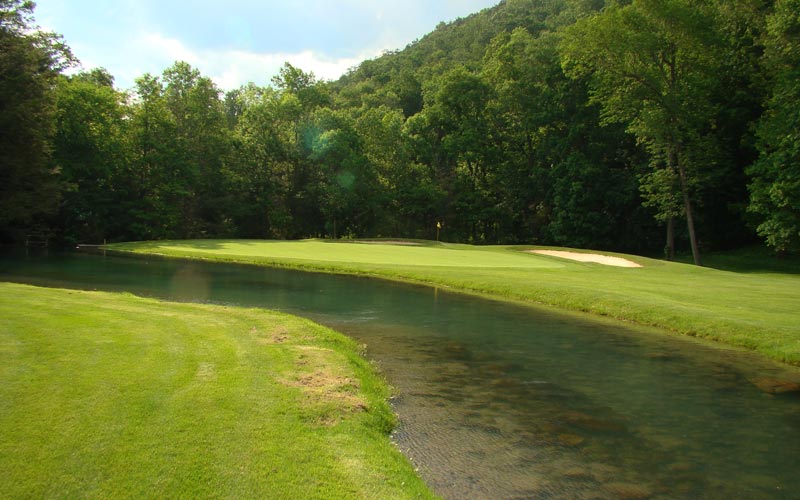
Regardless of whether it is in two or three shots, the approach to the sixteenth green is a nervy one.
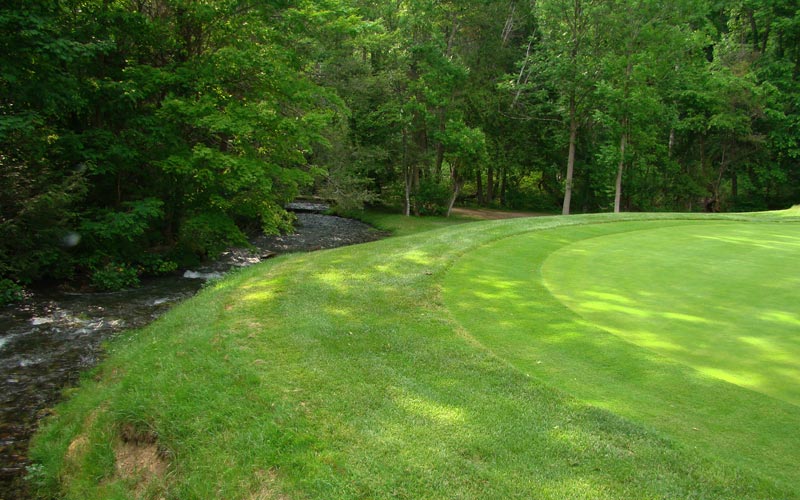
Front left hole locations are particularly cruel as the stream hugs the left side of the sixteenth green.
Seventeenth hole, 515 yards, Cress Lakes; As the sixteenth sweeps to the right, the seventeenth goes to the left around the base of a hill. In keeping with the rest of the course, no one shot pattern is favored and a player that can shape it both ways (like Virginia amateur great Vinny Giles) enjoys a distinct advantage over his competitor. Those who hug the inside of the dogleg left are afforded the best angle down the neck of the fairway that feeds past a natural water feature and onto the putting surface. Those who play cautiously away from the hill and toward the outside of the dogleg are left with a gummy angle toward the green across the water hazard.
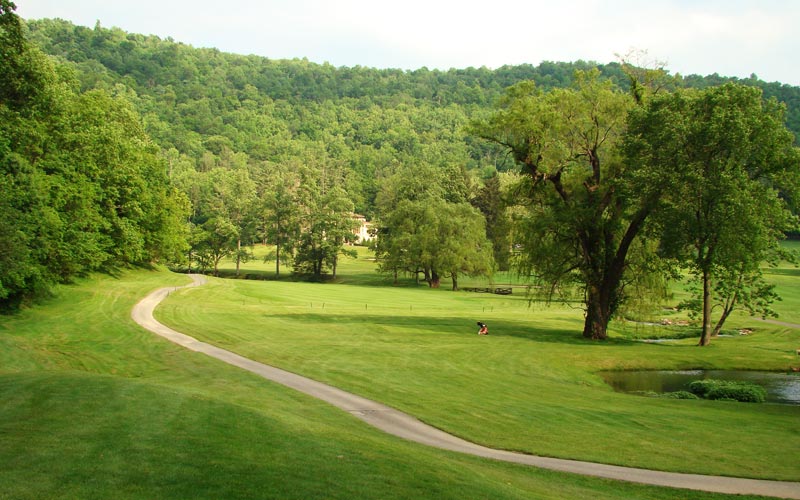
The beauty of the seventeenth hole is marred by one of the worst placements of a golf cart path ever. The ideal line off the tee is just inside the cart path as the golfer then won’t have to carry the water on his second shot.

A fitting feature for a penultimate hole at a course so named is cascading water and it is found here right of the seventeenth green. Many a golf ball has found this natural hazard from daring golfers attempting to reach the green in two.
Eighteenth hole, 205 yards, Taps; Just as Garden City Golf Club finishes with a one shotter, so too does The Cascades. A front hole location between the two greenside bunkers may be as hard as any hole location on the course, given the green’s fierce back to front tilt. Fortunes can swing wildly over these last three holes, making it one of the most interesting closing stretches in the game.
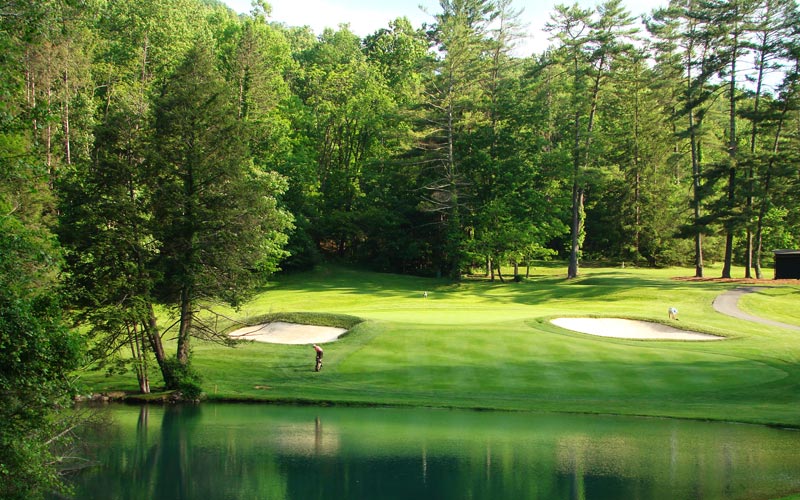
Keeping the ball below the hole is paramount as the eighteenth features more back to front pitch than any Flynn green on the course.
In summary, Flynn’s use of the natural topography, ponds and streams provides a stern test that is altogether unique and reminds one of no other course in the world. If the golfer tries to fight nature, he will come off worn and broken. However, the intelligent golfer who uses the slopes and places his ball correctly is mightily rewarded. Decade after decade, golfers keep coming back to figure out how to play The Cascades. Surely, this is the greatest compliment an architect and a course can receive?
If only the course still played as Flynn intended. Fortunately, The Homestead changed ownership hands in 2007 and hopefully the new owners will reverse the years of negligence that the course has suffered. The Master Plan that was presented to the previous owners by Wayne Morrison and Tom Paul in 2006 should be dusted off and carefully followed. Creeks that were covered at the fifth, sixth and tenth needed to be re-exposed. Flynn’s fourteenth and fifteenth holes need to be faithfully restored. The cart paths need to be reworked/removed and/or hidden. Fairway width needs to be recaptured, befitting the grandeur of such holes as the seventh and twelfth. And finally, hundreds of trees need to be removed so that the golfer can more freely appreciate that he is enjoying a game of golf in one of the world’s most beautiful spots. Given that, and given the luxuries of the nearby Homestead, golfers will forever be drawn to this special valley in the Allegheny Mountains.

The Georgian style Homestead is the anchor for this 15,000 acre mountain resort in the Allegheny Mountains. Travelers have come to Hot Springs for well over two centuries to sample the rejuvenating benefits of its natural hot springs.
Please note: the author wishes to thank Flynn historian Wayne Morrison (wsmorrison@hotmail.com)
for sharing his research information for this course profile.
The End


